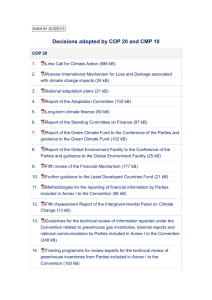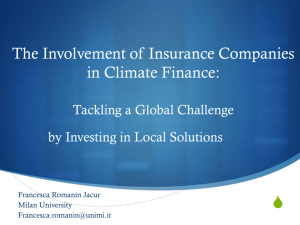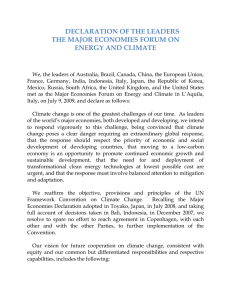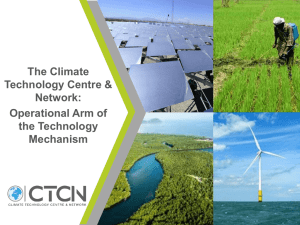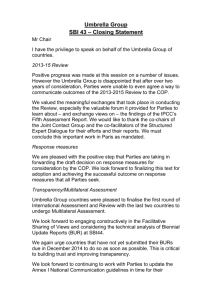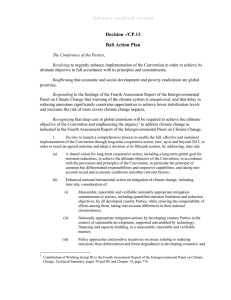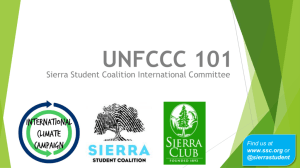COP 19 Outcomes
advertisement
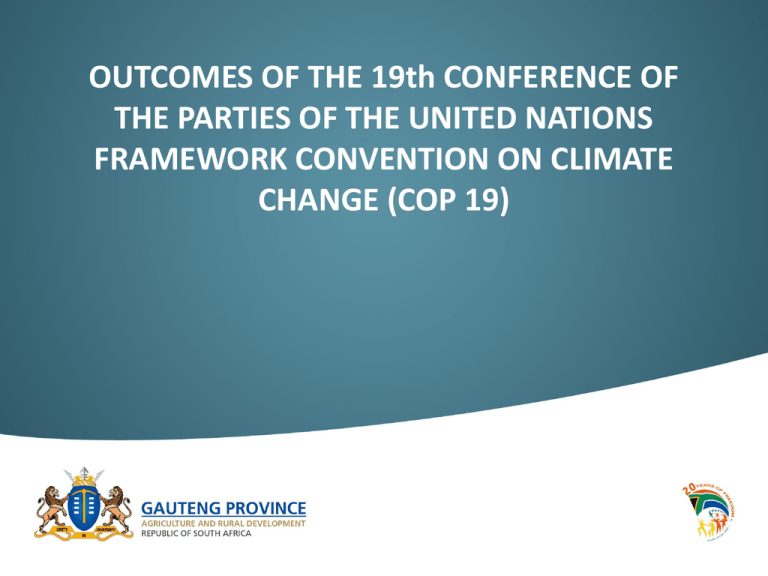
OUTCOMES OF THE 19th CONFERENCE OF THE PARTIES OF THE UNITED NATIONS FRAMEWORK CONVENTION ON CLIMATE CHANGE (COP 19) Background • The United Nations Framework Convention on Climate Change (UNFCCC) was formed to address the threat of climate change • It is an international environmental treaty produced at the United Nations Conference on Environment and Development (UNCED), informally known as the Earth Summit, held in Rio de Janeiro in 1992. • The objective of the treaty is to stabilize greenhouse gas concentrations in the atmosphere at a level that would prevent dangerous anthropogenic interference with the climate system. • The parties to the convention have met annually from 1995 in Conferences of the Parties (COP) to assess progress in dealing with climate change. In 1997, the Kyoto Protocol was concluded and established legally binding obligations for developed countries to reduce their greenhouse gas emissions. Background….. • The Conference of Parties (COP) is the only global negotiation platform aimed at achieving global reductions in Greenhouse Gas (GHG) emissions. • Given that climate change is a global issue it is imperative that Parties agree on a common framework within which to tackle this global challenge. • COP 19 was held in Warsaw, Poland from 11 November to 22 November 2013 and SA was represented. Key areas in addressing climate change • Mitigation – curbing greenhouse gas emissions • Adaptation - responding to the adverse effects of climate change • Monitoring and Evaluation • Finance Further advancing the Durban Platform - Mitigation COP 17 was held in 2011, Durban, SA. COP 17 paved a way for the second commitment period under the Kyoto Protocol since the first commitment period was coming to an end in 2011. • The COP requests the Ad Hoc Working Group on the Durban Platform for Enhanced Action to accelerate its development of a protocol, another legal instrument or an agreed outcome with legal force under the Convention applicable to all Parties • Resolves to accelerate the provision of means of implementation, including technology, finance and capacity-building support for developing country Parties, recognizing that such implementation will enhance ambition in the pre-2020 period. • Also resolves to enhance ambition in the pre-2020 period in order to ensure the highest possible mitigation efforts under the Convention. Loss and Damage - Adaptation Small-island states and other particularly vulnerable developing countries have pressed for years for greater attention to “loss and damage” resulting from extreme events and slow-onset impacts such as sea-level rise, which will be unavoidable even with strong mitigation and adaptation efforts. Parties agreed at COP 18 to reach a decision in Warsaw on “institutional arrangements” addressing loss and damage, and Typhoon Haiyan put the issue front and centre. • Establishes the Warsaw international mechanism for loss and damage, under the Cancun Adaptation Framework, subject to review at the twenty-second session of the Conference of the Parties (November–December 2016). • Also establishes an executive committee of the Warsaw international mechanism, which shall function under the guidance of, and be accountable to, the Conference of the Parties. Adaptation Plans • Encourages the Adaptation Committee to continue its work on providing technical support and guidance to the Parties, in particular in the area of national adaptation plans, and to seek further coherence and synergy with other relevant bodies and programmes under the Convention in implementing its workplan. • Emphasizes that undertaking the national adaptation plan process is an investment for the future that will enable countries to assess and prioritize adaptation needs in a coherent and strategic manner; • Welcomes the technical guidelines for the national adaptation plan process, which will assist the least developed country Parties in undertaking their national adaptation plan process, and which may be used by other Finance • Underlines the urgency of implementing commitments related to financing and transfer of technology under the Convention. • Recognizes the commitment undertaken by developed country Parties to a goal of jointly mobilizing USD 100 billion annually by 2020 to address the needs of developing countries in the context of meaningful mitigation actions and transparency on implementation. • Also recognizes the importance of providing clarity on the level of financial support that will be provided by developed country Parties to developing country Parties to allow for enhanced implementation of the Convention. • Requests Parties to enhance their enabling environments and policy frameworks to facilitate the mobilization and effective deployment of climate finance. Monitoring and Evaluation • Adopts the general guidelines for domestic measurement, reporting and verification of domestically supported nationally appropriate mitigation actions by developing country Parties. • Adopts the revised Guidelines for the preparation of national communications by Parties and decides that Annex I Parties shall use these guidelines in preparing their inventories. Implications • GDARD will implement projects and programmes that are aligned with the Conference’s outcomes and South African position or commitment on climate change issues.
